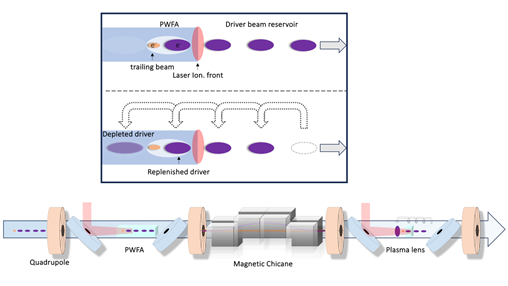Shortening the path: Towards multi-stage TeV plasma accelerators
Current radio-frequency technology for electron particle accelerators limits the energy gain to about 100 mega-electronvolt per meter acceleration length, before risking electrical discharge damage. This results in designs for a future tera-electronvolt (TeV) accelerator with a machine length of tens of kilometers.
In plasma-wakefield accelerators, gradients of many giga-electronvolt per meter are achieved, but only over centimeter-lengths. If the plasma wakefield is created by a driving electron bunch, its energy can be efficiently transferred to a trailing bunch. Lining up hundreds of such plasma accelerator stages, one could thus accumulate the energy of hundreds of “easily” produced few-GeV electron bunches into a single trailing bunch to achieve TeV-energies. In such a design, it is most critical to minimize the path length between the stages, needed to in- and outcouple driving bunches and transporting the trailing, or else the benefit of the high accelerating fields inside the plasma is lost.
In a study published in Physical Review Letters, scientists of LOA’s UPX research group propose a new method to shorten the path between stages: the femtosecond laser pulse that ionizes gas to a plasma for the plasma accelerator also acts as a gate. The reservoir bunches before the laser pulse do not see plasma and follow the trajectory set by magnets. The last two bunches after the laser pulse propagate in plasma, interact via a plasma wake-field, and transfer energy from the driving bunch to the trailing one.
The depleted former driving bunch and then train of reservoir bunches then get delayed by a short magnetic chicane, tuned such that the depleted bunch is effectively outcoupled, and the last of the reservoir bunches slots in place as a fresh driving bunch for the next plasma accelerator stage.
The simulations in this study show that this ingenious scheme allows the stages to be kept on meter-scale, so that an average acceleration gradient of 1 GeV/m can be estimated for a complete accelerator design for a final energy of 1 TeV and a total machine length of under 1 kilometer. With the suggested design, unchartered territory of particle physics could be accessed with machines of only a few kilometers in length.
Archive ouverte HAL.



